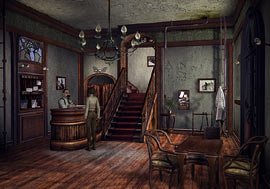
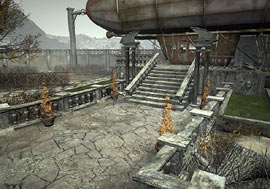

The triumphant return of the classic Adventure gaming genre is most evident
with the release of
Dreamcatcher Games latest title, Syberia for PC gaming platform. This gem of
last year’s E3 video gaming conference has the makings of a true classic
gaming experience, with its sweeping visual and graphic designs, an extremely
well written and intriguing storyline, and an incredibly intricate yet
interesting puzzle scheme that can be found throughout the game. Check out our
full review Syberia here at The Laser for what might be one of the best games
we’ve had a chance to play all year.
From
the extremely creative mind of Benoit Sokal and the wizardry of the gaming
designers at Microids comes one of the best games we’ve seen for the PC
platform this year: that being the
eagerly awaited release from Dreamcatcher Games, entitled Syberia. A classic
styled adventure game at its core, Syberia takes advantage of modern day gaming
technology and blends it seamlessly with those best attributes that have made
playing the adventure gaming genre the incredible experience that it is.
With Syberia, PC gamers not only have the opportunity to engage in a
title with rich and stunning visual dynamics, state of the art 3D effects, and
mind bending puzzles, but also one that contains an extremely well written
storyline and a compelling plot.
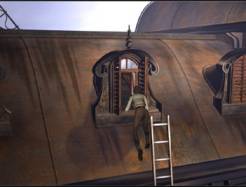 From
the initial start up of Syberia on our gaming rig, the staff here at The Laser
knew we were in for an incredible gaming experience. Though the visuals and
singular gameplay were raved about during the last E3 conference in
Los Angeles
, seeing them firsthand proved to be an
exhilarating experience, to say the least. A definite step back from the
adrenaline fueled action oriented titles that has become a mainstay of
popularity over the last few years, Syberia gives players the opportunity to put
on and use their thinking caps as they explore the many ‘old-world’ European
locales that make up the vast majority of the in-game scenarios.
Players take on the persona of Kate Walker, an American lawyer sent to
the tiny French Alps
village
of
Valadilene
in order to finalize the sale of the
towns’ infamous Voralberg Automaton factory, which has been used to make toys
and other fanciful gadgets over the years. Upon arrival, not only does Kate
learn that the factories’ owner, Anna Voralberg, has died, but her thought to
be long dead brother Hans Voralberg is actually alive and well. The factory now
legally belongs to him, which forces
Walker
to embark upon an incredible journey
across Western and
Eastern Europe
to find the Automaton Factory heir and
convince him to complete the sale that Anna Voralberg had started.
From
the initial start up of Syberia on our gaming rig, the staff here at The Laser
knew we were in for an incredible gaming experience. Though the visuals and
singular gameplay were raved about during the last E3 conference in
Los Angeles
, seeing them firsthand proved to be an
exhilarating experience, to say the least. A definite step back from the
adrenaline fueled action oriented titles that has become a mainstay of
popularity over the last few years, Syberia gives players the opportunity to put
on and use their thinking caps as they explore the many ‘old-world’ European
locales that make up the vast majority of the in-game scenarios.
Players take on the persona of Kate Walker, an American lawyer sent to
the tiny French Alps
village
of
Valadilene
in order to finalize the sale of the
towns’ infamous Voralberg Automaton factory, which has been used to make toys
and other fanciful gadgets over the years. Upon arrival, not only does Kate
learn that the factories’ owner, Anna Voralberg, has died, but her thought to
be long dead brother Hans Voralberg is actually alive and well. The factory now
legally belongs to him, which forces
Walker
to embark upon an incredible journey
across Western and
Eastern Europe
to find the Automaton Factory heir and
convince him to complete the sale that Anna Voralberg had started.
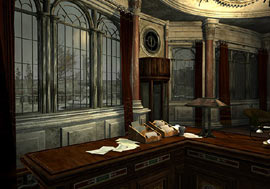 As
with most games within the ‘classic’ style of the adventure genre, Syberia
consists of a 3rd person, mouse based ‘point-and-click’ form of
gameplay, giving it a slow and methodical pace allowing gamers to take in each
and every nuance of the title; and believe us when we tell you that this game
has plenty of them. Sokal’s rich imagery and beautiful artistic visuals sweep
across every inch of the computer’s screen at almost every moment, from normal
moments of gameplay, to the incredible cut-scenes that helps the storyline
progress. The opening animated
cut-scene is a testament to the uncanny quality that has gone into producing
Syberia: the eerie automaton funeral
procession set against the picturesque background of the small French Alps city
of Valadilene is incredibly breathtaking, to say the least.
The only other aspect of the game that could give the graphical
presentation a run for its money lies in the highly orchestrated soundtrack that
happens to be layered deeply throughout the entire experience of Syberia. Not
unlike a well made film, however, the sounds and visuals of the game go hand in
hand, making the experience that much more enjoyable.
As
with most games within the ‘classic’ style of the adventure genre, Syberia
consists of a 3rd person, mouse based ‘point-and-click’ form of
gameplay, giving it a slow and methodical pace allowing gamers to take in each
and every nuance of the title; and believe us when we tell you that this game
has plenty of them. Sokal’s rich imagery and beautiful artistic visuals sweep
across every inch of the computer’s screen at almost every moment, from normal
moments of gameplay, to the incredible cut-scenes that helps the storyline
progress. The opening animated
cut-scene is a testament to the uncanny quality that has gone into producing
Syberia: the eerie automaton funeral
procession set against the picturesque background of the small French Alps city
of Valadilene is incredibly breathtaking, to say the least.
The only other aspect of the game that could give the graphical
presentation a run for its money lies in the highly orchestrated soundtrack that
happens to be layered deeply throughout the entire experience of Syberia. Not
unlike a well made film, however, the sounds and visuals of the game go hand in
hand, making the experience that much more enjoyable.
After
stripping away the aesthetics that made up the majority of the Syberia
experience, we still found the title exhibited the best attributes found within
an adventure game. Again, the
‘point-and-click’ style of gameplay made jumping into the fray very simple,
even for those unfamiliar with this particular genre of gaming.
The various forms of puzzles that are the driving force behind Syberia
and other games within the adventure genre tended to sway back and forth in
levels of difficulty. At times, figuring out what one needed in order to
progress in the storyline and complete a ‘puzzle’ or ‘quest’ that
happened to lie in a players’ path seemed almost too easy. Other times, we
actually had to rely on the cheat sheet that Dreamcatcher had so thoughtfully
included in order to complete a puzzle that had frustrated us so completely (for
those that don’t have the industry contacts, quite a few walkthroughs and
guides for the game can easily be found through all of the major search portals
and engines). As with most games
similar to Syberia, careful observation of one’s surroundings and paying
attention to conversations held with other in game character’s normally put
you on the right course to finishing a daunting task. A well crafted storyline
also helped keep the pace of the game’s action, as did the various settings
and interesting back story characters and plotlines. At every turn, there was
always something quite interesting and unexpected to be found within Syberia.
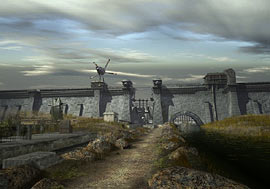 Though
the positive aspects of Syberia are plentiful, the game itself is not completely
perfect: but then again, not too many really are in the end.
A couple of minor flaws in the gameplay did cause some consternation, but
nothing that couldn’t be overlooked after truly involving ourselves within the
game. For starters, we found ourselves having to take notes during conversations
just so we didn’t miss any sort of important clue or plot line. It might have
been a good idea for Microids to add some a ‘conversation logging’ sheet on
the character interface console in order to keep track of important information.
What is truly odd about this situation is that it looks as if one exists
already, but it always remains blank. Believe
it or not, another major drawback to the game came in the form of too much
detail in certain locations. We found ourselves missing important items needed
for puzzle solving on more than one occasion simply for the fact that they
blended in almost too well with Sokal’s incredible artwork.
This wouldn’t be such a problem if this was a consistent practice.
Sometimes, items would stick out like a sore thumb, ready for players to pick
them up and add to your inventory for future puzzles and quests.
Other times, you’d have to search the area with your cursor inch by
inch until the ‘found’ icon appeared, and that’s only after checking out
the walkthrough files for help. Again, an annoying situation at best especially
after you wracked your brain over and over again, trying to figure out what
you’ve done wrong during a puzzle, only to find out later that the needed item
was right in front of you the whole time.
Though
the positive aspects of Syberia are plentiful, the game itself is not completely
perfect: but then again, not too many really are in the end.
A couple of minor flaws in the gameplay did cause some consternation, but
nothing that couldn’t be overlooked after truly involving ourselves within the
game. For starters, we found ourselves having to take notes during conversations
just so we didn’t miss any sort of important clue or plot line. It might have
been a good idea for Microids to add some a ‘conversation logging’ sheet on
the character interface console in order to keep track of important information.
What is truly odd about this situation is that it looks as if one exists
already, but it always remains blank. Believe
it or not, another major drawback to the game came in the form of too much
detail in certain locations. We found ourselves missing important items needed
for puzzle solving on more than one occasion simply for the fact that they
blended in almost too well with Sokal’s incredible artwork.
This wouldn’t be such a problem if this was a consistent practice.
Sometimes, items would stick out like a sore thumb, ready for players to pick
them up and add to your inventory for future puzzles and quests.
Other times, you’d have to search the area with your cursor inch by
inch until the ‘found’ icon appeared, and that’s only after checking out
the walkthrough files for help. Again, an annoying situation at best especially
after you wracked your brain over and over again, trying to figure out what
you’ve done wrong during a puzzle, only to find out later that the needed item
was right in front of you the whole time.
Other
than the few problems we found with certain minor aspects of the game, Syberia
proved itself to be one of the true gaming gems of the year.
Its incredible visual presentation, intriguing storyline, and above
average puzzle schemes have really helped put the Adventure genre back on the PC
gaming map. Toting a more methodical
pace of gaming, Syberia not only gives players the chance to experience
firsthand an incredible story, but also to exercise their cerebral muscles a
bit, problem solving. Add to that a
MSP of $29.99 (priced way below its quality level, in our opinion) this latest
release from Dreamcatcher Games is a definite bargain that even the cheapest fan
of Adventure gaming cannot ignore.
> Related Reviews
Beam Breakers
Preview (PC)
Rock Manager (PC)
The
Sum of All Fears (PC)
